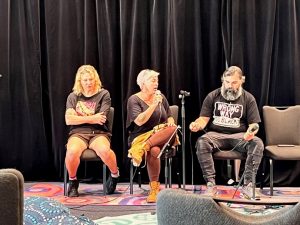Story by Roselle Tenefrancia
In the six years that we have been involved in publishing stories around recreational boating on the Kombumerri country (Gold Coast) and Quandamooka country (Moreton Bay area), we have met so many boating enthusiasts whose stories span from the early European settlement days to the present day. Contemporary recreation boating activities on the Southeast Queensland coast are inextricably connected to salt water – the ocean, the Broadwater, the rivers, the tidal waters surrounding the canal estates. But we seldom hear or read stories about how contemporary Aboriginal people are connecting with the land and water around us. In spite of modern motorised and sailing boats and fibreglass kayaks/canoes used on our waterways, the relationship Aboriginal people have with the waterways remains deeply rooted to country and culture.
In December 2021, we had the privilege of attending a yarning circle facilitated by Home of the Arts (HOTA), with the theme “Water Ways”. Artists with Aboriginal background led the story-telling about life and experiences on and along our local waterways — growing up and working in saltwater country, and the activism on reclaiming the right to manage water resources.
Listening to them share their stories as young children growing up on Kombumerri land (Gold Coast) provided a different perspective on our modern-day boating and fishing experiences. Justine Dillon, a Kombumerri and Quandamooka woman who is the project coordinator for Ngarang- Wal Gold Coast Aboriginal Association and Guanaba Indigenous Protected Area, told some of her fishing adventures catching queenfish with grandfather (Graham Dillon) and her father on the Broadwater. Raised in Paradise Point, Justine shares how those fishing activities with the elders are considered a rite of passage up to this day. Goompi Ugerabah, born on Kombumerri land but traces his ancestors to the Gurreng Gurreng tribal area (Bundaberg region), explains how, as a young child, he was taught to know when it is the right time to harvest oysters from the oyster reefs. He learned that when a particular native plant is blooming, it indicates that the oysters are good to eat. These are just a couple of examples of stories that reflect the contemporary life of Aboriginal people. Justine and Goompi are among the present Kombumerri elders who are passing on their Indigneous knowledge, skills, culture and practices to the next generation of Australians, both Indigenous and non-Indigenous.
We also listened to three contemporary artists explain their activism in the repatriation of land rights and water rights. Libby Harward, a descendant of the Ngugi people of Mulgulpin in Quandamooka area (Moreton Island) and an artist-activist whose “political practice engages traditional custodians in the evolution of ephemeral installations on mainland country”, expressed her concerns over the management and mismanagement of water. Together with Danni Zuvela, an artist, researcher and curator, and BJ Murphy, a visual artist, curator and songman dedicated to the continuation of the Jinibara culture, Libby explained their advocacy to change the narrative on water use. The Water Rites program in South Australia, a project with Danni, Libby and other artists, that explored water as a non-human actor, “investigated the ways water performs, works, manifests and asserts itself in human and other worlds through artworks, knowledge production and embodied acts.” Water is a being in itself and should not be privatised, commodified or financialised.
Generations of Indigenous communities have continuously lived on these lands and waters, and have adopted the technologies that allow all of us to live a modern life. However, in the past couple of centuries, resource use and management have exclusively been based on Westernised systems. Indigenous knowledge, culture and governance structures have been completely ignored, despite unequivocal evidence that these are more sustainable and indeed more equitable.
Boaties love sharing stories within their own yarning circles. But it is time to listen to the Indigenous storytellers, whose relationships with our waterways are deep and have been historically entrenched for thousands of years. The Aboriginal leaders and artists are steadfast in maintaining and promoting our primordial interconnections with everything around us. We are now called to not only acknowledge the past, but to actively and purposefully engage with the elders whose knowledge and culture are deeply rooted within our ecosystems.
We are dedicating this space for the stories of the First Nations people whose ancestors have passed on the wisdom and the connections that are being kept alive to this day for the future generations.
NOTE: The December yarning circle included William Barton, Australia’s leading didgeridoo player and highly esteemed composer, instrumentalist, and vocalist, and Aunty Delmae Barton, singer, songwriter and poet. William shares his music in a soon-to-be screened film, River, a cinematic and musical odyssey that explores the remarkable relationship between humans and rivers.
HELP PROTECT OUR WATERWAYS
Protecting our waterways is a shared responsibility. Respect the marine environment, reduce speed near shorelines, practise safe refueling, discharge out at sea and take your rubbish with you.
Published in print January-March 2022




























